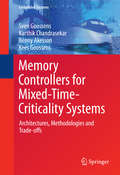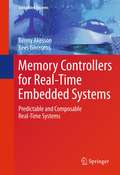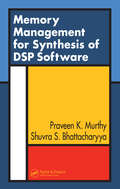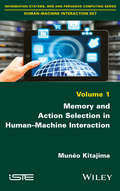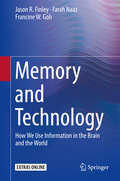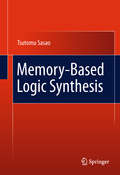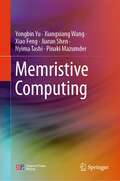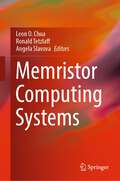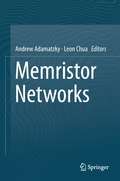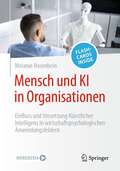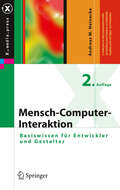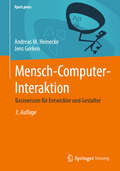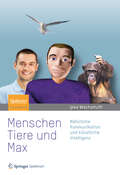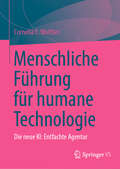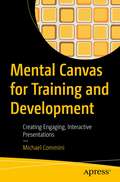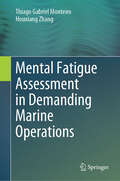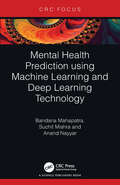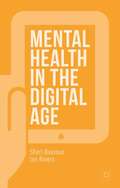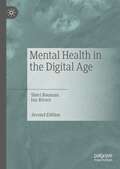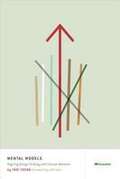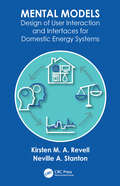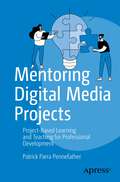- Table View
- List View
Memory Controllers for Mixed-Time-Criticality Systems
by Kees Goossens Benny Akesson Sven Goossens Karthik ChandrasekarThis book discusses the design and performance analysis of SDRAM controllers that cater to both real-time and best-effort applications, i. e. mixed-time-criticality memory controllers. The authors describe the state of the art, and then focus on an architecture template for reconfigurable memory controllers that addresses effectively the quickly evolving set of SDRAM standards, in terms of worst-case timing and power analysis, as well as implementation. A prototype implementation of the controller in SystemC and synthesizable VHDL for an FPGA development board are used as a proof of concept of the architecture template.
Memory Controllers for Real-Time Embedded Systems
by Kees Goossens Benny AkessonVerification of real-time requirements in systems-on-chip becomes more complex as more applications are integrated. Predictable and composable systems can manage the increasing complexity using formal verification and simulation. This book explains the concepts of predictability and composability and shows how to apply them to the design and analysis of a memory controller, which is a key component in any real-time system.
Memory Management for Synthesis of DSP Software
by Shuvra S. Bhattacharyya Praveen K. MurthyAlthough programming in memory-restricted environments is never easy, this holds especially true for digital signal processing (DSP). The data-rich, computation-intensive nature of DSP makes memory management a chief and challenging concern for designers. Memory Management for Synthesis of DSP Software focuses on minimizing memory requirements during the synthesis of DSP software from dataflow representations. Dataflow representations are used in many popular DSP design tools, and the methods of this book can be applied in that context, as well as other contexts where dataflow is used.This book systematically reviews research conducted by the authors on memory minimization techniques for compiling synchronous dataflow (SDF) specifications. Beginning with an overview of the foundations of software synthesis techniques from SDF descriptions, it examines aggressive buffer-sharing techniques that take advantage of specific and quantifiable tradeoffs between code size and buffer size to achieve high levels of buffer memory optimization.The authors outline coarse-level strategies using lifetime analysis and dynamic storage allocation (DSA) for efficient buffer sharing as one approach and demonstrate the role of the CBP (consumed-before-produced) parameter at a finer level using a merging framework for buffer sharing. They present two powerful algorithms for combining these sharing techniques and then introduce techniques that are not restricted to the single appearance scheduling space of the other techniques.Extensively illustrated to clarify the mathematical concepts, Memory Management for Synthesis of DSP Software presents a comprehensive survey of state-of-the-art research in DSP software synthesis.
Memory and Action Selection in Human-Machine Interaction
by Munéo KitajimaThe first goal of this book is to extend Two Minds originating from behavioral economics to the domain of interaction, where the time dimension has to be dealt with rigorously; in human-machine interaction, it is of crucial importance how synchronization between conscious processes and unconscious processes is established for a sense of smoothness, and how memory processes and action selection processes are coordinated. The first half this book describes the theory in detail. The book begins by outlining the whole view of the theory consisting of action selection processes and memorization processes, and their interactions. Then, a detailed description for action selection processes theorized as a nonlinear dynamic human behavior model with real-time constraints is provided, followed by a description for memorization processes. Also, implications of the theory to human-machine interactions are discussed. The second goal of this book is to provide a methodology to study how Two Minds works in practice when people use interactive systems. The latter half of this book describes theory practices in detail. A new methodology called Cognitive Chrono-Ethnography (CCE) is introduced, which adds the time dimension to Hutchins' Cognitive Ethnography, in order to practice "know the users" systematically by designing user studies based on a simulation of users' mental operations controlled by Two Minds. The author then shows how CCE has been applied to understanding the ways in which people navigate in real physical environments by walking and by car, respectively, and explores the possibility of applying CCE to predict people's future needs. This is not for understanding how people use interfaces at present but to predict how people want to use the interfaces in the future given they are currently using them in a certain way Finally, the book concludes by describing implications of human-machine interactions that are carried out while using modern artefacts for people's cognitive development from birth, on the basis of the theories of action selection and memorization.
Memory and Technology: How We Use Information in the Brain and the World
by Jason R. Finley Farah Naaz Francine W. GohHow is technology changing the way people remember? This book explores the interplay of memory stored in the brain (internal memory) and outside of the brain (external memory), providing a thorough interdisciplinary review of the current literature, including relevant theoretical frameworks from across a variety of disciplines in the sciences, arts, and humanities. It also presents the findings of a rich and novel empirical data set, based on a comprehensive survey on the shifting interplay of internal and external memory in the 21st century. Results reveal a growing symbiosis between the two forms of memory in our everyday lives.The book presents a new theoretical framework for understanding the interplay of internal and external memory, and their complementary strengths. It concludes with a guide to important dimensions, questions, and methods for future research.Memory and Technology will be of interest to researchers, professors, and students across the disciplines of psychology, philosophy, library and information science, human factors, media and cultural studies, anthropology and archaeology, photography, and cognitive rehabilitation, as well as anyone interested in how technology is affecting human memory._____ "This is a novel book, with interesting and valuable data on an important, meaningful topic, as well as a gathering of multidisciplinary and interdisciplinary ideas...The research is accurately represented and inclusive. As a teaching tool, I can envision graduate seminars in different disciplines drawing on the material as the basis for teaching and discussions." Dr. Linda A. Henkel, Fairfield University "This book documents the achievements of a vibrant scientific project – you feel the enthusiasm of the authors for their research. The organization of the manuscript introduces the reader into a comparatively new field the same way as pioneering authors have approached it." Prof. Dr. Wolfgang Schönpflug, Freie Universität Berlin
Memory-Based Logic Synthesis
by Tsutomu SasaoThis book describes the synthesis of logic functions using memories. It is useful to design field programmable gate arrays (FPGAs) that contain both small-scale memories, called look-up tables (LUTs), and medium-scale memories, called embedded memories. This is a valuable reference for both FPGA system designers and CAD tool developers, concerned with logic synthesis for FPGAs.
Memristive Computing
by Pinaki Mazumder Xiao Feng Yongbin Yu Xiangxiang Wang Jiarun Shen Nyima TashiThis book delves into a wide array of topics, ranging from memristor and its emulator to chaotic circuits based on memristor, memristor-based en/decryption systems, filter design based on memristive family, memristive filter for signal processing, memristor network-based swarm intelligence, dynamic analysis of memristive neural networks, and the application of memristor-based neural networks. It provides a comprehensive and systematic exploration of how memristors empower and drive cutting-edge research in neuromorphic computing and artificial intelligence. This book encourages fostering interdisciplinary information literacy and cultivating cross-disciplinary computational thinking. This book plays a pivotal role in embracing and advancing the development of neuromorphic computing. Through profound foundational theories and academic analysis methods, this book guides artificial intelligence graduate students and engineering professionals in constructing a comprehensive knowledge and technological framework for memristor research.
Memristor Computing Systems
by Ronald Tetzlaff Leon O. Chua Angela SlavovaThis contributed volume offers practical solutions and design-, modeling-, and implementation-related insights that address current research problems in memristors, memristive devices, and memristor computing. The book studies and addresses related challenges in and proposes solutions for the future of memristor computing. State-of-the-art research on memristor modeling, memristive interconnections, memory circuit architectures, software simulation tools, and applications of memristors in computing are presented. Utilising contributions from numerous experts in the field, written in clear language and illustrated throughout, this book is a comprehensive reference work. Memristor Computing Systems explains memristors and memristive devices in an accessible way for graduate students and researchers with a basic knowledge of electrical and control systems engineering, as well as prompting further research for more experienced academics.
Memristor Networks
by Leon Chua Andrew AdamatzkyUsing memristors one can achieve circuit functionalities that are not possible to establish with resistors, capacitors and inductors, therefore the memristor is of great pragmatic usefulness. Potential unique applications of memristors are in spintronic devices, ultra-dense information storage, neuromorphic circuits and programmable electronics. Memristor Networks focuses on the design, fabrication, modelling of and implementation of computation in spatially extended discrete media with many memristors. Top experts in computer science, mathematics, electronics, physics and computer engineering present foundations of the memristor theory and applications, demonstrate how to design neuromorphic network architectures based on memristor assembles, analyse varieties of the dynamic behaviour of memristive networks and show how to realise computing devices from memristors. All aspects of memristor networks are presented in detail, in a fully accessible style. An indispensable source of information and an inspiring reference text, Memristor Networks is an invaluable resource for future generations of computer scientists, mathematicians, physicists and engineers.
Men Are From Cyberspace
by Jodie Gould Lisa SkriloffDon't dial up your Prodigy account without this one!Straight from the publishing vaults comes Men Are from Cyberspace, the finest online dating self-help book 1997 had to offer. All the Clinton-era single ladies agree, this classic tome will demystify the brave new world of romance on the information superhighway as it was meant to be (before Friendster and MySpace came along and ruined it). For anyone seeking an (ironic) trip down memory lane, you will learn the answers to such timeless questions as:* How do I find a newsgroup that's right for me?* What's the best way to make a chat-room entrance?* Are you a cyberaddict? Take this quiz and find out!Complete with a list of obsolete websites, usenets and cyber cafes, your entire romantic life will flash before your eyes as your read the (unintentionally) hilarious advice on virtual beaus, cybersex and other dating secrets for women in the "modern era". And if you ever wondered how your parents hooked up before Tinder, Men Are from Cyberspace: The Single Woman's Guide to Flirting, Dating, & Finding Love may provide some much needed insight about your mother's love life.
Mensch und KI in Organisationen: Einfluss und Umsetzung Künstlicher Intelligenz in wirtschaftspsychologischen Anwendungsfeldern
by Melanie HasenbeinDieses Buch "Mensch und KI in Organisationen" zeigt Ihnen auf, welchen Einfluss die Künstliche Intelligenz und Robotik auf den Menschen in der aktuellen und zukünftigen Arbeits- und Organisationswelt hat. Das Werk nimmt Sie mit auf die Reise der Künstlichen Intelligenz in einzelnen psychologischen und wirtschaftspsychologischen Anwendungsfeldern.Auf der Basis von theoretischem Hintergrundwissen und aktuellen Studien sowie praktischen Umsetzungsmöglichkeiten erfahren Sie:wie Künstliche Intelligenz die Arbeits- und Organisationswelt verändert,was eine Mensch-KI-Interaktion und Mensch-Roboter-Interaktion kennzeichnet,wo KI und Roboter im Human-Resources-Bereich eingesetzt werden,welche zukünftigen Lernszenarien mit KI und Robotern möglich sind,wie eine hybride Führung und Teamarbeit zwischen Mensch, KI und Robotern aussehen kann und welche ethischen Grundsätze beim Einsatz von KI und Robotern zu berücksichtigen sind. Das Buch ist angereichert mit digitalen Fragen und Antworten, die Sie über die Flashcard App zum Selbsttest nutzen können. Die ZielgruppenProfessionals im Organisations- und Personalbereich, Berater, Trainer und CoachesStudierende der Wirtschaftspsychologie sowie der Angewandten und Digitalen Psychologie
Mensch-Computer-Interaktion
by Andreas M. HeineckeJeder hat schon die Erfahrung gemacht, dass Webseiten nicht lesbar sind oder Programme unverständliche Meldungen hervorbringen. Kurz: Die Software ist nicht gebrauchstauglich. Ausgehend von der menschlichen Informationsverarbeitung legt der Autor dar, wie Schnittstellen beschaffen sein müssen und wie bei der Entwicklung vorgegangen werden muss, damit die Software gebrauchstauglich wird. Dabei werden neueste Normen und Vorschriften berücksichtigt. Die begleitende Website bietet weitere Beispiele und Übungsaufgaben, Lösungen und weiterführende Links.
Mensch-Computer-Interaktion: Basiswissen für Entwickler und Gestalter (Xpert.press)
by Andreas M. Heinecke Jens GerkenJeder hat das schon einmal erlebt: Webseiten, auf denen man die Schrift nicht lesen kann, Informationsterminals, bei denen man nicht erkennt, wo man drücken soll, Programme, die unverständliche Meldungen hervorbringen, kurz: Software, die nicht gebrauchstauglich ist. Dieses Buch enthält Basiswissen, das alle benötigen, die gebrauchstaugliche Software erstellen wollen. Ausgehend von der menschlichen Informationsverarbeitung erläutern die Autoren, wie Benutzungsschnittstellen beschaffen sein müssen und wie bei der Entwicklung von Anwendungen vorzugehen ist, damit Menschen die Software sinnvoll nutzen können. Das Buch berücksichtigt die aktuellen Normen und Vorschriften anhand praktischer Beispiele. Diese dritte erweiterte und komplett überarbeitete Auflage integriert neben aktuellen technologischen Entwicklungen auch die Erfahrungen aus mehr als 20 Jahren Lehre in der Mensch-Computer-Interaktion. Auf der Webseite mci-buch.info sind Lösungen zu den Aufgaben, weitere Beispiele und Übungsaufgaben, inhaltliche Ergänzungen, und weiterführende Links zu finden.
Menschen, Tiere und Max
by Ipke Wachsmuth"Nur selten fragt die Wissenschaft nach dem roten Faden, der Lebendiges mit Technischem, Mensch mit Tier und beide mit Computern oder Robotern verbindet. Dieses lesenswerte Buch ist ein brillanter Führer durch den Themendschungel - und unerlässlich für jeden, der sich über den Stand der Forschung informieren will." Gert Scobel, 3sat"Was ist Kommunikation? Ein Pionier des digitalen Zeitalters nimmt uns mit auf eine spannende Reise: von Menschen und Tieren zu Computern und Robotern, die uns zunehmend ähneln und zugleich verändern und in Frage stellen. Wer sind wir, und wie werden wir künftig miteinander umgehen? Zugleich augenzwinkernd und tiefgründig und vor allem immer authentisch baut Ipke Wachsmuth beim Leser nicht nur Unwissen ab, sondern auch Ängste und Sorgen." Manfred Spitzer, Autor von "Lernen" und "Medizin für die Bildung"Wie gelingt Kommunikation? Unter welchen Voraussetzungen verstehen wir einander? Wie lernen Kleinkinder, sich zu verständigen? Wie kommunizieren Tiere untereinander und mit uns? Und schließlich: Können Roboter und virtuelle Agenten zu vertrauenswürdigen und einfühlsamen Dialogpartnern und Helfern werden? Ipke Wachsmuth führt den Leser auf einen spannenden Streifzug durch die Vielfalt und Komplexität der kommunikativen Fähigkeiten. Immer wieder begegnet uns dabei Max, ein Kunstmensch aus der virtuellen Realität, an dem sich ganz konkret das Funktionieren von Kommunikation und Fragen über die Möglichkeiten künstlicher Intelligenz erörtern lassen. Aus dem Epilog: Ich erwache, weil Max mich ruft. Von der schimmernden Wand, die ein einziges riesiges Display ist und die hinter ihm nun das Tagespanorama von Seoul zeigt, begrüßt er mich mit fröhlichem Gesicht: "Guten Morgen, Ipke, acht Uhr! Ausgeschlafen? Du hast doch um zehn Uhr einen Termin." ... Jetzt aber los. Halt, wie war das noch mit der freundlichen Begrüßung? "Max? Wie sagt man nochmal ,Guten Tag' in Korea?" Max sogleich: "An-nyeong ha-se-yo", und weiter: "Du musst in einer Viertelstunde aufbrechen." Also doch noch Zeit für ein wenig Entspannung. "Max, gib mal etwas Musik." Er kennt ja meine Lieblingsstücke, aus meinem iTunes. Max wählt ein Bluesstück aus und tanzt dazu. Ich greife zum Couchtisch, wo meine Bluesharp liegt, und jamme etwas, variiere das eine oder andere, bis es richtig groovt. _____ Möwen, Krabben und Marktschreier - ausgehend von Alltagsbeobachtungen beleuchtet Ipke Wachsmuth in diesem Buch die Themen Kommunikation, natürliche und künstliche Intelligenz. Es geht dabei um Sprache und Denken, um Mimik und Gestik - und um die Komplexität hinter den so alltäglich erscheinenden kommunikativen Fähigkeiten von Menschen und Tieren. Das Buch führt auch in die Welt von Robotern und anderen künstlichen Wesen ein, die unseren künftigen Alltag mehr und mehr bevölkern werden. Max ist ein "lebendes" Beispiel dafür, wie die Schnittstelle zwischen Mensch und Computer in Zukunft aussehen könnte. Doch wie erzeugt man ausdrucksvolle Sprache? Wie lassen sich Gesichtsausdrücke technisch nachahmen? Welche Rolle spielt der Sprechrhythmus für unsere Kommunikation? Wie ist die hochentwickelte Wortsprache des Menschen entstanden, die uns von allen Tieren unterscheidet? Bildgebende Verfahren machen es heute möglich, dem Hirn beim Denken "zuzuschauen" und damit auch Einblicke in die Prozesse des Sprachverstehens zu erlangen, die man mit künstlicher Intelligenz nachzuahmen versucht. Zu den weiteren Themen des Buches gehören Gebärdensprachen, der Zusammenhang von Zeichen und Bedeutung sowie die Wirkung von spontanen Körperbewegungen und Körperhaltung für die Übermittlung von Botschaften. Spannend ist die Frage, inwieweit Tiere und Menschen sich über Bedeutsames austauschen können. Sind Menschenaffen in der Lage, Symbole zu gebrauchen und absichtsvoll zu kommunizieren, verfügen sie vielleicht sogar über Bewusstsein? Und wird sich ein Maschinenwesen wie Max eines Tages mit uns aus der Perspektive eines eigenen "Ich" unterhalten können? Maschinen mit "Eigenleben" - kann es und soll es die geben? Könnten sie einfühlsame Partner des Menschen werden...
Menschliche Führung für humane Technologie: Die neue KI: Entfachte Agentur
by Cornelia C. WaltherDieses Buch untersucht die Beziehung zwischen natürlicher und künstlicher Intelligenz in unserer sich schnell entwickelnden Welt. Es tut dies, verankert in einem innovativen multidisziplinären Rahmen und der Prämisse, dass die Gesellschaft eine Zusammensetzung aus mehreren Dimensionen ist, mit Individuen (Mikro), Gemeinschaften (Meso), Ländern (Makro) und dem Planeten (Meta) in der kollektiven Sphäre, und Individuen selbst als multidimensionale Wesen (Bestrebungen, Emotionen, Gedanken, Empfindungen). Diese Perspektive wird angewendet, um die Auswirkungen unseres Übergangs in eine Phase zu analysieren, in der Online- und Offline-Bereiche zunehmend miteinander verflochten sind. Besonderes Augenmerk wird auf den Einfluss der allgegenwärtigen Technologie auf unsere Wahrnehmung des Selbst und der Gesellschaft gelegt. Die zentrale Botschaft ist, dass wir lernen müssen, Agency inmitten von KI zu nutzen, was doppelte Alphabetisierung – menschliche und algorithmische im Hinblick auf natürliche und künstliche Intelligenz – erfordert.
Mental Canvas for Training and Development: Creating Engaging, Interactive Presentations
by Michael ComminiTake advantage of layering and other digital techniques to create stunning, interactive compositions suitable for delivering instructional content and presentations on your iOS or Android device. This book shows you how to move from traditional paper and pen drawing to 3D content that can be interacted with by the viewer. Designed to be used on tablets, the Mental Canvas app is a reimagining of presentation software in the digital age that uses patented technology developed by a research team at Yale University. Whether producing concept drawings, storyboards, tutorials, sales presentations, or other forms of interactive media, you’ll learn the skills to transform boring presentations into something exciting and new! You’ll create stunning panoramic views; allow viewers to move through your artwork with multiple scenes; publish to the web for viewing on any smart phone, tablet, or computer; import image files; and export animated fly-throughs as .mp4 files. Mental Canvas can be used by individual creatives or as part of a collaborative design team sharing files between multiple devices giving global instructional design firms an edge over their competition. Provide fun, interactive, and engaging presentations and throw out those boring click-through, static presentations of the past. Business Dashboards, Organizational About Us pages, Sales presentations – virtually whatever the organization’s creatives can think up you’ll learn to develop in Mental Canvas!What You'll LearnUse layering to create stunning 3D effects in an otherwise static 2D imageImport and adapt existing images into your dynamic presentationCreate .mp4 fly-throughs that bring websites and presentations to life with videoWho This Book Is ForAny creative who wishes to build engaging and interactive presentations with their iOS or Android device.
Mental Fatigue Assessment in Demanding Marine Operations
by Houxiang Zhang Thiago Gabriel MonteiroThis book investigates how human mental fatigue (MF) can be objectively measured during demanding maritime operations. The maritime domain is characterized by demanding operations. These operations can be especially complex and dangerous when they require coordination between different maritime vessels and several maritime operators. The best approach to quantify MF is through the use of physiological sensors including electroencephalogram (EEG), electrocardiogram, electromyogram, temperature sensor, and eye tracker can be applied, individually or in conjunction, in order to collect relevant data that can be mapped to an MF scale. More than simpler sensor fusion, this book bridges the gap between relevant sensor data and a quantifiable MF level using both data-driven and model-based approaches. Data-driven part investigates the use of different NNs combined for the MF assessment (MFA) task. Among the different architectures tested, convolutional neural networks (CNN) showed the best performance when dealing with multiple physiological data channels. Optimization was used to improve the performance of CNN in the cross-subject MFA task. Testing different combinations of physiological sensors indicated a setup consisting of EEG sensor only was the best option, due to the trade-off between assessment precision and sensor framework complexity. These two factors are of great importance when considering an MFA system that could be implemented in real-life scenarios. The model-based discussion applies the current knowledge about the use of EEG data to characterize MF to develop an MF approach to quantify the progression of MF in maritime operators. In the research presented in this book, realistic vessel simulators were used as a platform for experimenting with different operational scenarios and sensor setups.
Mental Health Prediction using Machine Learning and Deep Learning Technology
by Anand Nayyar Bandana Mahapatra Suchit MishraToday the integration of technologies like Machine Learning (ML) and Deep Learning (DL) are enabling us to understand, predict, and manage the rising mental health concerns better. This volume provides a comprehensive roadmap for researchers, practitioners, and enthusiasts to explore how artificial intelligence can revolutionize mental healthcare. The book delves into the cutting-edge innovations in predictive modeling, offering insights into how ML and DL algorithms can analyze complex psychological data, detect early warning signs, and predict mental health outcomes. Designed for a diverse audience, including data scientists, mental health professionals, and students, it combines technical rigor with real-world applications. With case studies, hands-on examples, and future-forward discussions, this book empowers readers to contribute to the next wave of mental health solutions powered by AI.
Mental Health in the Digital Age
by Sheri Bauman Ian RiversThe internet can now be reached by a fingertip on a smart phone and has changed our lives on a fundamental level. However, is mental health enhanced or diminished by this digitisation of our world? Innovation, such as digital technology, is often greeted with fear and suspicion but there is currently little evidence to support this. This book examines the intersection of mental health and digital technology in order to make informed decisions about the new options provided by the internet and technology. It highlights the rise in online therapy, self-help sites and social media as well as examining the ethical dilemmas involved in online research to suggest that the benefits created far outweigh the possible risks.
Mental Health in the Digital Age
by Sheri Bauman Ian RiversThis second edition of this highly impactful book examines the intersection of mental health and digital technology to make informed decisions about the new options provided by digital technology. It highlights the rise in online therapy and social media and examines the ethical dilemmas involved in online research to suggest that the benefits created far outweigh the possible risks. This expanded and updated second edition, includes practical suggestions for clinicians and public, builds upon the first by updating readers on recent developments in technology and research in this area since 2015. It explores ways in which governments and practitioners responded to the mental health crisis caused by the Covid-19 pandemic, and looks at the challenges as well as the benefits of our increasing interaction online.
Mental Models
by Indi YoungThere is no single methodology for creating the perfect product--but you can increase your odds. One of the best ways is to understand users' reasons for doing things. Mental Models gives you the tools to help you grasp, and design for, those reasons. Adaptive Path co-founder Indi Young has written a roll-up-your-sleeves book for designers, managers, and anyone else interested in making design strategic, and successful.
Mental Models: Design of User Interaction and Interfaces for Domestic Energy Systems
by Neville A. Stanton Kirsten M. RevellThere is a resurgence of interest in mental models due to advances in our understanding of how they can be used to help design and due to the development of practical methods to elicit them. This book brings both areas together with a focus on reducing domestic energy consumption. The book focuses on how mental models can be applied in design to bring out behaviour change resulting in increased achievement of home heating goals (reduced waste and improved comfort). This book also offers a method to extract and apply mental models to interface design. The approach enables mental models to be applied across domains when behaviour change was sought, and is validated as a useful design method.
Mental Penguins: The Neverending Education Crisis and the False Promise of the Information Age
by Ivelin SardamovProfessor Ivelin Sardamov draws on key findings in neuroscience to explain the waning interest in and knowledge of complex social issues in the United States and around the world. Attributing this trend primarily to the effects of information overload, ubiquitous screens and constant access to the internet, Sardamov argues that chronic over-stimulation generated by the current sociotechnological environment fosters addictive tendencies in today's young people.
Mentoring Digital Media Projects: Project-Based Learning and Teaching for Professional Development
by Patrick Parra PennefatherMentoring is often a crucial, yet informal part of an organization’s best practices and skill development, whether targeted towards a team lead, project manager, designer, developer or a valued senior team member. This book provides practical strategies and methodologies for professionals to mentor others to successfully develop and deliver digital media projects across different types of settings.Many professionals working with teams in the digital media industry (games, web development, XR, IoT, mobile) are drawn to teaching others, but may not know how or where to start. Many might be a subject expert but may not have the structure and skills in place to be able to teach others effectively in workplace and institutional settings. This handbook will give professionals a guide on how to mentor junior designers, developers and other learners in formal and informal learning environments. Mentoring Digital Media Projects offers the right tools and strategies to use in digital media and emerging tech projects for you to better guide junior team members What You'll Learn Understand the difference between mentoring and teachingDesign thinking strategies to better identify where, when and how you can help and mentor othersBuild mentoring pipelines, end-to end, especially in post-secondary learning environmentsCreate emerging technology projects with teams Who This Book Is For Digital media professionals (game, web development, XR, mobile, IoT, etc.) who have experience working in teams in their specific discipline and who want to mentor others.
Merch Domination: The Ultimate Guide to Merch by Amazon
by Neil LMerch by Amazon has been the premier place for print on demand t-shirt designs since late 2015. This platform is easy to learn but hard to master. When you get the hang out if, Merch by Amazon can easily replace your full time income and could potentially lead to a nice six figure a year side income if you practice the lessons laid out in this Amazon Merch book. Learn from those who have done it before and continue to be some of the top power sellers on Merch. If you are interested in setting up a profitable Merch by Amazon t-shirt business, then you need to read the entire Merch Domination book. Within the hundreds of pages you will learn how to sell your custom artwork and novelty designs on Amazon with print on demand t-shirts. Take advantage of the biggest ecommerce retailer the world has ever known
